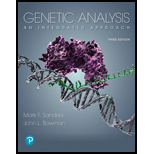
Genetic Analysis: An Integrated Approach (3rd Edition)
3rd Edition
ISBN: 9780134605173
Author: Mark F. Sanders, John L. Bowman
Publisher: PEARSON
expand_more
expand_more
format_list_bulleted
Concept explainers
Textbook Question
Chapter 20, Problem 4P
Describe how natural selection can produce balanced polymorphism of allele frequencies through selection that favors heterozygotes.
Expert Solution & Answer
Want to see the full answer?
Check out a sample textbook solution
Students have asked these similar questions
What is the difference between Uniporters, Symporters and Antiporters? Which of these are examples of active transport?
What are coupled transporters?
What are “domains” and how do they aid in protein function?
Chapter 20 Solutions
Genetic Analysis: An Integrated Approach (3rd Edition)
Ch. 20 - 20.1 Compare and contrast the terms in each of the...Ch. 20 - In a population, what is the consequence of...Ch. 20 - 20.3 Identify and describe the evolutionary forces...Ch. 20 - Describe how natural selection can produce...Ch. 20 - Thinking creatively about evolutionary mechanisms,...Ch. 20 - 20.6 Genetic drift, an evolutionary process...Ch. 20 - Over the course of many generations in a small...Ch. 20 - Catastrophic events such as loss of habitat,...Ch. 20 - 20.9 George Udny Yule was wrong in suggesting that...Ch. 20 - 20.10 The ability to taste the bitter compound...
Ch. 20 - Figure 20.6 illustrates the effect of an ethanol ...Ch. 20 - 20.12 Biologists have proposed that the use of...Ch. 20 - 20.13 Two populations of deer, one of them large...Ch. 20 - 20.14 Directional selection presents an apparent...Ch. 20 - 20.15 What is inbreeding depression? Why is...Ch. 20 - 20.16 Certain animal species, such as the...Ch. 20 - Genetic Analysis 20.1 predicts the number of...Ch. 20 - 20.18 In a population of rabbits, and . The...Ch. 20 - Sickle cell disease (SCD) is found in numerous...Ch. 20 - 20.20 Epidemiologic data on the population in the...Ch. 20 - The frequency of tasters and nontasters of PTC...Ch. 20 - Tay-Sachs disease is an autosomal recessive...Ch. 20 - 20.23 Cystic fibrosis (CF) is the most common...Ch. 20 - 20.24 In the mouse, Mus musculus, survival in...Ch. 20 - 20.25 In a population of flowers growing in a...Ch. 20 - Assume that the flower population described in the...Ch. 20 - 20.27 ABO blood type is examined in a Taiwanese...Ch. 20 - 20.28 A total ofmembers of a Central American...Ch. 20 - 20.29 A sample offield mice contains individuals...Ch. 20 - Prob. 30PCh. 20 - Albinism, an autosomal recessive trait...Ch. 20 - 20.32 The frequency of an autosomal recessive...Ch. 20 - 20.33 Evaluate the following pedigree, and answer...Ch. 20 - Evaluate the following pedigree, and answer the...Ch. 20 - The following is a partial pedigree of the British...Ch. 20 - Draw a separate hypothetical pedigree identifying...Ch. 20 - Prob. 37PCh. 20 - 20.38 Achromatopsia is a rare autosomal recessive...Ch. 20 - 20.39 New allopolyploid plant species can arise by...
Knowledge Booster
Learn more about
Need a deep-dive on the concept behind this application? Look no further. Learn more about this topic, biology and related others by exploring similar questions and additional content below.Similar questions
- What are intrinsically disordered proteins, and how might they be useful for a living system?arrow_forwardWhat are Amyloid Fibrils? What biological functions are these known to perform?arrow_forwardHow do histamine and prostaglandins help in the mobilization of leukocytes to an injury site? What are chemotactic factors? How do they affect inflammation process?arrow_forward
- Compare and contrast neutrophils and macrophages. Describe two ways they are different and two ways they are similar.arrow_forwardDescribe the effects of three cytokines (not involved in the initial inflammation response). What cells release them?arrow_forwardDescribe activation of helper T cells or cytotoxic T cellsarrow_forward
- Compare and contrast MHC 1 and MHC 2. Describe two way they are different and two ways they similar including how they are used in antigen presentation.arrow_forwardDescribe two antimicrobial properties of the skin.arrow_forwardDescribe how the inflammation response starts including the sentinel cells and the chemicals involved. How do pathogens trigger the response particularly in the skin?arrow_forward
- How does complement promote the immune response? Describe three waysarrow_forwardWhich of the following is not a possible mechanism for autoimmunity? Select one: A. Abnormal expression of MHC II molecules in non-antigen-presenting cells B. Activation of polyclonal B cells C. Polymorphism of HLA alleles D. Molecular mimicry E. Release of sequestered antigensarrow_forwardWRITTEN WORK 3: NON-MENDELIAN GENETICS Part A: Complete the Punnett square and calculate for the probability of genotype and phenotype. i i Genotype: Phenotype: 08:55arrow_forward
arrow_back_ios
SEE MORE QUESTIONS
arrow_forward_ios
Recommended textbooks for you
 Human Heredity: Principles and Issues (MindTap Co...BiologyISBN:9781305251052Author:Michael CummingsPublisher:Cengage Learning
Human Heredity: Principles and Issues (MindTap Co...BiologyISBN:9781305251052Author:Michael CummingsPublisher:Cengage Learning Biology (MindTap Course List)BiologyISBN:9781337392938Author:Eldra Solomon, Charles Martin, Diana W. Martin, Linda R. BergPublisher:Cengage Learning
Biology (MindTap Course List)BiologyISBN:9781337392938Author:Eldra Solomon, Charles Martin, Diana W. Martin, Linda R. BergPublisher:Cengage Learning

Human Heredity: Principles and Issues (MindTap Co...
Biology
ISBN:9781305251052
Author:Michael Cummings
Publisher:Cengage Learning

Biology (MindTap Course List)
Biology
ISBN:9781337392938
Author:Eldra Solomon, Charles Martin, Diana W. Martin, Linda R. Berg
Publisher:Cengage Learning
What is Evolution?; Author: Stated Clearly;https://www.youtube.com/watch?v=GhHOjC4oxh8;License: Standard Youtube License